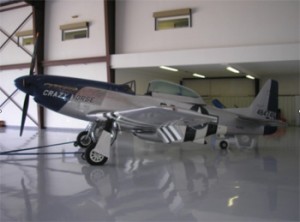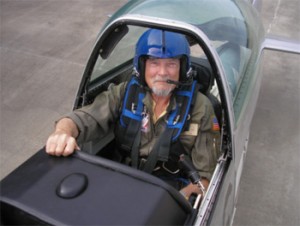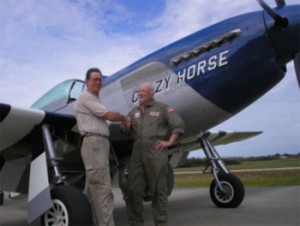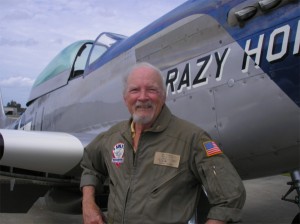 By Harry “Gipper” Morris
By Harry “Gipper” Morris
KISSIMMEE AIRPORT KISM
INTRODUCTION
Monday, 0900hrs, I arrived at Stallion51 where I was introduced to Steve Larmore, a 41-year veteran pilot with more than 12,000hrs flight time, an AP&IA mechanic, and the one who looks after all of Stallion51 warbirds including the TF-51s and AT-6s. Steve was to be my instructor this day and I felt completely comfortable and honored to be flying with him
GROUND BRIEFING & START UP
After a pre-flight ground briefing, we climbed aboard this magnificent flying machine, “Crazy Horse”, got buckled in, and a long pre-start check list was called out from memory by Steve who manned the front seat position. Then, engine-start. What a sound a 1450hp Merlin engine makes from inside the cockpit. You know you are sitting aboard a powerful machine, something quite different from anything you have ever flown before. All systems check; all systems OK. We are ready to go. “Mustang 5 ready to taxi”. The photo below is the front seat instrument panel. The rear seat panel is very similar.
 TAXI & TAKE OFF
TAXI & TAKE OFF
The wind was again howling across the runway 20kts gusting to 27kts at a 50deg angle from the left of the departure runway which translates into about a 15 to 20kt direct crosswind takeoff. We had been observing several other light aircraft trying to land on the runway with some difficulty. Some had to go-round and others managed with a very low wing into the wind. A Gulfstream landed with a pretty low wing, so we were very careful about taxing and preparation for take-off conditions. Steve handled it superbly. Turn into the wind, engine run-up, taxi onto the runway, cleared for Take Off, and off we go.
DEPARTURE
After about a 30deg right climbing turn out, and about a minute, Steve turns the controls over to me. So, I’m holding 170kts, 46inMP and 2700rpm. My vertical climb indicator tells me that we are climbing near 2000fpm. WaHooo!!! This plane is something else. I didn’t feel any turbulence after takeoff. The plane is completely stable and loves to climb. After flying around and through 3 layers of scattered clouds between 4,000 and 7,000ft, I leveled off at 8,500ft in no time at all.
MANEUVERS
 This is where I begin the maneuvers, starting with sharp left and right turns, then slow flight at 95kts. The plane feels solid as a rock as I make shallow turns left, then right, and it still likes to climb. I’m beginning to “feel” the airplane now. I find myself already at 11,500ft. Stalls come next. The plane stalls below 70kts starting with a slight buffet, then a good buffet. Recovery is easy with rudder controls to level wings if necessary, then aileron controls. How about that for an airplane who’s max speed is 360kts at 15,000ft. From stalls, we go straight into Wing-Overs, left and right, followed by Aileron Rolls, left and right. Everything is still OK. Steve is giving me a good work-out.
This is where I begin the maneuvers, starting with sharp left and right turns, then slow flight at 95kts. The plane feels solid as a rock as I make shallow turns left, then right, and it still likes to climb. I’m beginning to “feel” the airplane now. I find myself already at 11,500ft. Stalls come next. The plane stalls below 70kts starting with a slight buffet, then a good buffet. Recovery is easy with rudder controls to level wings if necessary, then aileron controls. How about that for an airplane who’s max speed is 360kts at 15,000ft. From stalls, we go straight into Wing-Overs, left and right, followed by Aileron Rolls, left and right. Everything is still OK. Steve is giving me a good work-out.
Next comes the Barrel Rolls performed between 13,000 and 14,500ft. This is the point where I wanted to pay a farewell tribute to my Dad, a WWII B-29 pilot who flew over Japan during the war, and in honor of all Veterans on Veterans Day this coming Wednesday. I was set up just fine; started the first Barrel Roll to the left. It was pretty sloppy and I gained a lot of altitude but managed to return close to the beginning point. Said my farewells to my Dad, and started a Barrel Roll right. This one was much better. Steve didn’t let me think about it very much and I went straight into Loops. Two Loops at 3Gs, and both went just fine. Next came a Cuban 8. I had never done these before but I had practiced some semblance of these on a simulator. I was pretty pleased with myself because it went just fine with top speeds at about 290kts and 3Gs
The final maneuver was the Clover Leaf. Now, I had to admit that I had never heard of a Clover Leaf, much less knew how to perform it. I asked Steve to show me with his hands how it would work and all he said was that he would just talk me through it. “Geez, thanks a lot, Steve.” So, I just followed his instructions and did the first one, well, maybe fair. The next one was a little better, but I never did understand completely what I was doing until we talked about it back on the ground. Then I wished I could go back and do it again. Four of these make a perfect 4-leaf clover. OK, now I get it. Wonder if I’ll ever have another opportunity to perform a 4-Leaf Clover in the future, or even a single Clover Leaf?

OVERHEAD BREAK
By now, it was time to start back to home base. Way too soon for me. I could do this stuff all day if I could afford it. But anyhow, I started my decent from 13,000ft at about 225kts. We are about 30nm from home base, so after weaving around and through the lower cloud levels, we are back at the airport and setting up for an Over-Head Break at 1000ft. At mid-field, I start the Break Right into downwind. Still there is a strong crosswind but I continue the turn onto base and final approach, Everything is perfect and at about 200agl, I hand the controls back over to Steve for the Landing. He does a fine cross-wind landing, just slightly right of centerline, but I should complain? I kidded him a little bit and told him I was glad he was flying it instead of me. We laughed about it because he said this was the strongest cross-wind landing he had ever done in a P-51 himself. A great job if I say so myself!!
TAXI TO RAMP
After clearing the runway, Steve gave me back the plane for taxing. This was another first for me and I was tickled to have the opportunity to do so. It was pretty easy to do. Steve took back the plane to park it and go through engine check list and shut-down and that was that. The final challenge was getting out of the cockpit. It’s a tight fit but quite comfortable and I was surprised to be able to do it with these old bones that don’t move as well as they use to. But no problems.
After a few ground photos of Steve and I outside the plane, we go back to the briefing room where the video tape is reviewed and we talked about some of the maneuvers. Then, we had to break off because another pilot was waiting his turn at flying this magnificent flying machine.
 The Stallion51 staff, including ground crew, instructors, and administration personnel, were very friendly and helpful during my entire time I was there. My many thanks and sincere appreciation go out to all of them. My special thanks goes to my flight Instructor today, Steven F. Larmore, CFII, AP/AI.
The Stallion51 staff, including ground crew, instructors, and administration personnel, were very friendly and helpful during my entire time I was there. My many thanks and sincere appreciation go out to all of them. My special thanks goes to my flight Instructor today, Steven F. Larmore, CFII, AP/AI.
I wish everyone could have the opportunity to fly one of these airplanes. I’m sure it would be just as much of a life-time thrill and unforgettable memory to cherish, as it has been for me. It is indeed, “A Dream Come True.”
Respectfully submitted
Cheers,
Harry “Gipper” Morris
